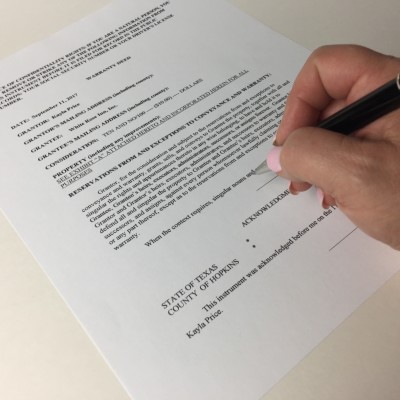
This is truly a random post. But, it is important.
My sister and I have a title company. It is a place where people go to sign papers when they want to buy and sell real property (land, houses, apartment building, commercial property, etc.) or to refinance an existing loan.
We do not make loans. Rather, we work on behalf of the lender, if there is one, and the buyers and sellers to get all the required paperwork properly executed. We also abstract, offer title insurance, check to see if anyone is on the terrorist watch list, collect overdue taxes, AJs, any liens, etc. So, pretty much Texas title companies are all that and a bag of chips!
We often run into an ink issue. Old school folks, like myself, were taught that the only ink to use when signing important, business documents is black. Many of our customers like to use their own personal pens to sign said important documents. The problem comes up when they pull out a pen that writes in black ink.
We must process these documents, copying all and sending originals for recording at the County Clerk’s Office, sending some originals to the lender, maintaining some originals and copies, sending copies home with customers. We try to do all this quickly because often customers are waiting for those copies.

For the documents that get notarized, we are good. We use blue ink and our notary stamps print in blue. However, for the majority of the documents, we don’t write on them.
County Clerks will only record original documents. We have gone round and round with folks trying to locate originals of powers of attorney, wills, etc. and they think a copy is an original signed and notarized in black.
All this to say, that these days, with copiers, scanners and printers on every desktop, I hope our business teachers are teaching students to use blue (or green or purple) ink to sign important papers. Not only does it help at the time the papers are signed, but it will also be helpful later when trying to locate original documents.
Bonus Information: To try to determine an original from a copy, the spit test is often employed. Lick your index finger and rub it lightly over the black ink of the signature line or notary stamp. If it smears, voila, you have an original signature. If it doesn’t, then you likely have a copy.
The only problem with this test is if the signer used a check signing security pen which disappears when it gets wet. Then you just erased part of the signature!


Kayla I just found your post while searching for something else. It is as darling as you are! Your site provided a spot of gentility within a rushed morning., and you can bet I’ll return. It was as refreshing as a cup of tea and a chat with a friend!
You are so sweet! Thank you for your comments. We must do tea one day!